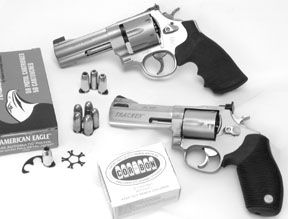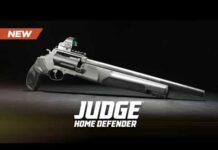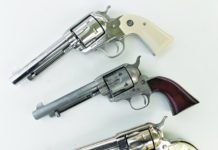
There was a time when a self-defense handgun meant nothing less than a big-bore double-action revolver. While many favored the friendlier .44 Special over its rowdy big brother, the .44 Magnum, popularity of another wide-body cartridge, the .41 Magnum, never quite took off. It was just about this same time that the semi-automatic pistol began making a dent in the self-defense market, and the search for the ultimate revolver cartridge for police use was nearly called off. Although .45 ACP is rarely thought of when considering the purchase of a wheelgun, this venerable round has been filling the chambers of revolvers for longer than most people think. In fact there are characteristics of today’s .45 ACP revolvers that in one regard make them a throwback to the 19th century.
Earlier in revolver production reloading was accomplished by replacing the entire cylinder. It could be said that along this same line the moon clip was born. Originally, moon clips carried three rounds held together by a flat metal stamping so that each round lined up with the chambers in a 180-degree arc that resembles a half moon. Today, clips are available that hold a full count of six rounds. These have become known as full-moon clips, and the original design using two clips of three have now been renamed “half-moon” clips.
Today, no less than two manufacturers are producing .45 ACP revolvers that utilize moon clips. Taurus recently joined Smith & Wesson in producing forty-fives, and this should give pause to fans of revolvers that sport large muzzles. Smith & Wesson has been producing its 625 series for quite some time and has now (reportedly) answered demands from the Practical Shooting community to make some basic changes. For one, the new 625-8 includes a barrel that is supposed to be friendlier to lead bullets. Taurus on the other hand has released a five-shot forty-five in its Tracker design. By limiting capacity to five rounds and making the cylinder smaller in diameter, Taurus was able to create a smaller frame revolver for handier carry. We recently tested one of each gun. The Smith sells for $745; the Taurus for substantially less, only $525.
Each of our test pistols offered 4-inch barrels, but since the design intent of each gun is different, we tested not only for basics such as accuracy and dependability, but also to see if we can judge which revolver has best fulfilled its individual promise.
Range Session
With sight radii longer than 5 inches, our test revolvers qualified for the full shooting distance of 25 yards. We supported the barrels on a cloth pillow-style sandbag with the bottom of our hands on a solid wooden bench. Five separate five-shot groups were recorded, fired single-action only. We used a BeamHit target system to refine our double-action technique, but DAO was only used for break-in and casual fire. Afterward, we measured velocity with a Oehler 35P chronograph.
[PDFCAP(1)]The primary selection of ammunition included Federal American Eagle 230-grain full metal jackets (FMJ), as well as a 200-grain +P hollowpoint from Cor-Bon. Winchester USA white box ammunition in the 185-grain weight was the third cartridge. Its profile is generally referred to as a truncated cone (TC). Because the Smith & Wesson 625-8 was reportedly barreled specifically for lead, we tried a handload popular with 1911 and revolver shooters alike. This consisted of GAT’s 230-grain roundnosed lead (RNL) bullet with Hodgdon’s Clays powder. Our load worked out to be just a tenth of a grain or so short of making USPSA major power factor and was very comfortable to shoot. Here’s what we learned:
Smith & Wesson 625-8, $745
The basic 625 revolver was introduced in 1989, and has largely retained its basic design — it’s a stainless-steel N-frame revolver with full-lug 5-inch barrel, adjustable sights and a tall plain Patridge blade up front. However, the input of competitive shooters and the rules under which they compete has reportedly fostered the arrival of the “dash-eight” model 625. Organizations that govern this style of handgun competition include the United States Practical Shooting Association (USPSA), the International Practical Shooting Conference (IPSC), the International Confederation of Revolver Enthusiasts (ICORE), and the International Defensive Pistol Association, or IDPA. The change to the shorter 4-inch barrel makes the 625-8 legal for IDPA, which prefers that shooters use what is generally considered to be standard “carry” equipment. Interest in revolver shooting has recently prompted the USPSA and IPSC to change the reward for winning from merely a single “High Revolver” trophy to Division status, wherein awards are given for several classes based on relative ability.
[PDFCAP(2)]Much to the dismay of seven- and eight-shot revolver shooters, the latest rules declare that no more than six shots can be fired without a reload. This is where the new model 625-8 comes in. With so many reloads required per course of fire, the gun that gives you the best chance of winning is the one that can be refilled the fastest. A look at the cylinder of the 625-8, which is mostly open chambers, should tell you which gun that is. Indeed, with the use of full moon clips and attributes such as a cartridge that is tapered, short, heavy and topped with a smooth round surface, it is no wonder the 625 has proven to be the revolver of choice for competition.
Still, revolver expert Jerry Miculek opines that this new model has been improved, with several subtle changes making the gun more competitive in the Practical Shooting arena. Miculek is beyond question the fastest double-action shooter of his time or, probably ever. He said he had been after Smith & Wesson for years to make several changes, including:
• The rifling of the 625-8 is designed for lead bullets.
• The cylinder has been shortened, so the bullet spends less time before engaging the rifling. This also reduces “torque-over,” the jolt from starting and stopping the motion of the cylinder.
• The interior dimension below the top-strap has not been altered, but the barrel and forcing cone have been extended across the cylinder gap.
• The target sights are still in place, and there is still plenty of sight radius despite the shorter barrel and long front-sight blade.
In our hands, we noticed the dash-eight steers from target to target noticeably faster than 5- and 6-inch models. The last time we tested a 625 variant (November 2000), it too was a 4-inch model, but without the full underlug. The extra material directly under the barrel is worth 5 ounces of recoil control.
The most recent production Smith & Wesson revolvers, including the 625-8, feature a key-operated lock on the left side of the frame that freezes the gun’s action. We’d also like to point out that moon-clip revolvers such as the 625 and the Taurus 455 should encourage their owners to put in play another safe practice. That is, storing the gun and ammunition separately. Should the need arise these revolvers can be charged much faster than other revolvers, even with the use of speedloaders that are either slower to use or less secure than moon clips.
In our choice of test cartridges, we almost forgot about the 625-8’s alleged preference for lead. But then we were not overly impressed with performance from the 230-grain jacketed rounds nor with the way it handled the +P Cor-Bon ammunition. So we decided to try a handload consisting of Hodgdon’s Clays powder and the 230-grain roundnosed lead (RNL) bullet from GAT, (800) 640-7145, X0093. Even when loading a selection of well-used brass with mixed headstamp, we dumped 25 shots into a group measuring under three inches from the bench at 25 yards. Recoil with the lead bullets was significantly reduced due to less friction compared to the jacketed 230-grain rounds from Federal. Winchester’s 185-grain FMJ round was the best of the jacketed trio, averaging 2.8 inches for five five-shot groups, however. The best individual group firing this round measured only 1.2 inches. But our 25-shot lead target displayed a 1-inch gaping hole that we estimate was home to 10 to 15 separate hits.
We felt the double-action trigger was heavier than it needed to be, even taking into account that in some smaller hands, the big N frame can make the hands work a little harder. But Smith & Wesson revolvers respond so well to trigger work that we feel a heavy stock trigger is not an issue, especially if the action is smooth and consistent, which in this case it was.
To our surprise the 625-8 comes only with half-moon clips, so we weren’t able to demonstrate any lightning fast reloads. Full-moon clips and a tool for stripping the spent cases can be purchased through
Taurus 455 Tracker, $525
Our first impression upon releasing the cylinder of the Tracker was, “Only five shots?” In our estimation Taurus decided to sacrifice the sixth round to make a smaller package that would be lighter, easier to carry and perhaps more popular. We are willing to bet that in terms of sales, smaller revolvers greatly surpass larger ones. But aside from reducing the capacity and making it smaller (comparable to Smith & Wesson’s L frame), the Tracker 455 is similar to the 625-8 in that it is finished in matte stainless steel, carries a full-lug barrel and adjustable rear sights.
[PDFCAP(3)]Features that set it apart from the 625 include a soft-ribbed rubber grip instead of the Smith’s Hogue Monogrip. The ribs collapse, fitting in between the fingers to conform while the Hogue is hard rubber, relieved at the back, and offers deep finger grooves up front. The Tracker’s front sight is on a tall stanchion, and the ramped blade is not only double-pinned in place but shows serration and an orange insert. The notch of the rear blade is outlined in white. Taurus’s internal lock is located on the hammer, and the pop-up design simply blocks the hammer from moving back. The crane of the 455 is braced by a spring-loaded detent pin. This is a nice upgrade, standard on all the Trackers.
The cylinder release is checkered, but it resembles an older design that Smith & Wesson has since abandoned for a sleeker cut that doesn’t impede ingoing or outgoing brass. Smith & Wesson has also gone to an integral cut ejector that braces itself inside the rear of the cylinder. Taurus still uses pegs that can break off. Both guns can be fired without stringing the cartridges into clips, but you will need fingernails to remove the spent cases. This is because the ejector star does not contact the rim of each cartridge directly. Instead it pushes out the center of the clip. The 625-8’s half-moons are more rigid than full-moon clips, but we really liked the Taurus full-moon clips. The area between shells is relieved, creating a spring action that means loading and stripping (unloading) the clips can be done by hand with little effort.
Certainly Taurus has not produced this revolver with Practical Shooting competition in mind. This is not to say the gun cannot be fired and reloaded quickly. The trigger is smooth and fast. At 11 pounds double action, most shooters will want to leave it stock and let a pound or two wear away naturally. But in terms of competition, the 455 doesn’t meet the rules to the shooter’s best advantage. Five shots is not really enough to be competitive, and the porting system puts the Tracker in the “Open” division against some real high-tech hardware.
On that point, the porting on the Tracker differs from the porting system found on a number of other Taurus models. In this case there is not an expansion chamber surrounding the area below the ports. Instead, the ports come directly through the rifling. In our experience with ported and compensated handguns, we prefer this design. We have seen where an expansion chamber removes some of the necessary pressure to make the ports work. However, some calibers respond better to porting than others. Pressure, supplied by the expanding propellants, is the key. This means hotter rounds are better. If you look at the Open division guns of USPSA/IPSC, for example, the choice of .38 Super is unanimous.
What we’re getting at is that guns chambered for the wide .45 ACP cartridge are not going to benefit as much from porting. The best bet in the case of the Tracker 455 would be to load a hot frangible like the one from MagSafe, (407) 834-9966, or a superlight solid like Aguila’s 117-grain hollowpoint, (Natchez Shooting Supply, [800] 251-7839). Otherwise, we feel there is little to gain from porting a forty-five.
In terms of accuracy, our Tracker shot an average group size of approximately 3 inches across the board. Like the Smith & Wesson 625-8, the Tracker liked the Winchester 185-grain FMJ rounds the best among our selection of factory ammunition. The Tracker showed no great propensity for lead bullets, however. Performance with our lead handload only meant there was more cleaning to do.
Gun Tests Recommends
Smith & Wesson 625, $745. Buy It. The 4-inch barrel makes for a speedy point, and its preference for lead helps the handloader and closes the gap between the cost of target loads and self-defense ammunition. It would be Our Pick for six-shot practical matches.
Taurus 455 Tracker, $525. Buy It. In our opinion the Tracker series is a step up from Taurus’s basic line, and we feel the .45 ACP model is no exception. Its smaller frame makes it handier to tote, and an upcoming 2-inch model should make it even more appealing.
The Tracker is a modern defense gun that we feel will benefit most from modern defense ammunition as listed above. Its size fits in with such advertising lingo as “backpacker” or “trail” gun. As a self-defense offering, this .45 ACP would be Our Pick.




























